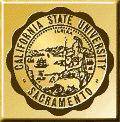 |
Introduction to Historical Skills History 100: Section 01 MW 1:30-2:45, Mendocino Hall 3009
|
 |
Introduction to Historical Skills History 100: Section 01 MW 1:30-2:45, Mendocino Hall 3009
|
Course Description
This course is designed to introduce first and second year history majors to methods of historical research and writing. With this goal in mind, students will be asked to produce an extended research essay on a topic of their choice. Over the course of the semester, class members will be doing a lot of research, thinking, talking, and writing on a variety of historical topics and subjects. In the first weeks of this schedule, much of this work will take the form of identifying, analyzing and acquiring the skills of professional historians. How do they work? What do they mean by evidence, and how do they go about collecting it? How do they come up with new ideas, interpretations, and arguments? In the last ten weeks or so of the course, each class member will develop a project for research and analysis. From this point, each student in the class will write a proposal for this project, develop a working bibliography, engage in careful research using primary and secondary sources, and generate an interpretation that contributes to the work of other scholars in the field or subject area. Because this class is a research seminar, along the way, each student will be expected to work closely with their colleagues in the class, sharing ideas, advice, and sources.
Course Objectives
1. Writing
The primary goal of History 100 is to introduce students to the practices, problems and strategies involved in the writing of history. With this goal in mind, the course will address issues of style, narrative, argument, and the literary decisions involved in the movement from the collection of evidence to the writing up of findings in essay form. Accordingly, students in the course will need to acquire the following skills.
2. Research Skills
Many of the tasks involved in historical research will continue to reflect traditional skills. These skills involve the finding and use of paper, microfilm, and microform documents, the use of collection finder’s guides and hard-copy bibliographies, and the use of published materials that may be considered too fugitive or unwieldy to be made available electronically. In other words, a working mastery of traditional (library or archive-based) research will continue to be necessary for the historian. Accordingly, students in History 100 will need to work on acquiring the following skills.
3. Computer-Enhanced Research
In recent years, there have been enormous strides made in electronic resources, in their availability to scholars, their trustworthiness as scholarly sources, and their usefulness in facilitating the process of research. Accordingly, students in history 100 will need to acquire the following skills.
Course Requirements
1. SACLINK Accounts: All students enrolled in this class must have a SACLINK account in order to access data base collections, on-line bibliographies, and indexes through the CSUS library system. Any student who does not have a SACLINK account at the beginning of the class must have one by the second week of instruction.
2. Research Materials: Students in the class will be expected to purchase at least 50 5x7 note cards. These cards should be purchased by the second week of instruction.
3. Attendance: As much as possible, this class will be taught as a seminar. This means that each student in the course will be responsible for setting the tone of the class, establishing its schedule, and generating its subjects for discussion. In other words, your presence is crucial to the success of this course. Accordingly, regular, active attendance is mandatory and will be factored into your grade. If you miss a class, you will still be responsible for that day’s material, even if the absence is "excused." If you disappear for an extended length of time (three or more classes in a row), you should consider yourself out of the class, and should not expect to be allowed back in. If you miss more than four classes, but feel you are still passing the class in your written work, you should not be surprised if you fail the class in your final grade.
4. Graded Work: Each student must complete the following sequence of assignments.
Grading will be based on the traditional A-F format. The two early essays, along with your project proposal and bibliography, will each count for 10% of your grade in the course [for a total of 30%]. Your research essay – including rough drafts – will count for 60% of your grade. The final 10% of your grade will be based on attendance, participation in class discussion, and the ways you meet your responsibilities in making the class work on a daily basis.
Course Texts
Tentative Schedule of Meetings and Discussion Topics